Top Special Education Grants for Teachers in 2025
Discover the best special education grants for teachers to fund your classroom in 2025. Learn how to apply and boost your resources today!

Special education teachers are innovators, constantly seeking new ways to create inclusive and effective learning environments. However, great ideas often require resources that stretch beyond tight school budgets. This is precisely where special education grants for teachers become transformative, providing the necessary funds to bring ambitious classroom projects to life. Securing this funding can introduce adaptive technology, specialized sensory materials, and crucial professional development opportunities, directly impacting your students' academic and personal growth.
The challenge is often knowing where to look. Navigating the world of grant applications can feel overwhelming, with countless websites and complex requirements. This comprehensive guide simplifies the entire process. We have compiled and analyzed 12 of the best grant sources available, from large federal programs to foundation awards and even accessible crowdfunding platforms.
In the list below, you will find a detailed breakdown of each opportunity. We provide direct links, key eligibility requirements, award amounts, and deadlines to help you efficiently identify the best fit for your specific needs. Our goal is to equip you with the information needed to confidently apply for and win the funding that will help you build the classroom your students deserve.
1. Fundsprout | Grant Success Platform
Fundsprout distinguishes itself as a premier grant success platform, leveraging advanced AI to streamline the entire funding lifecycle for educators. It’s an exceptional tool for teachers seeking special education grants for teachers, moving far beyond simple grant databases. The platform automates the most time-consuming aspects of grant seeking, from discovery to proposal writing and final reporting.
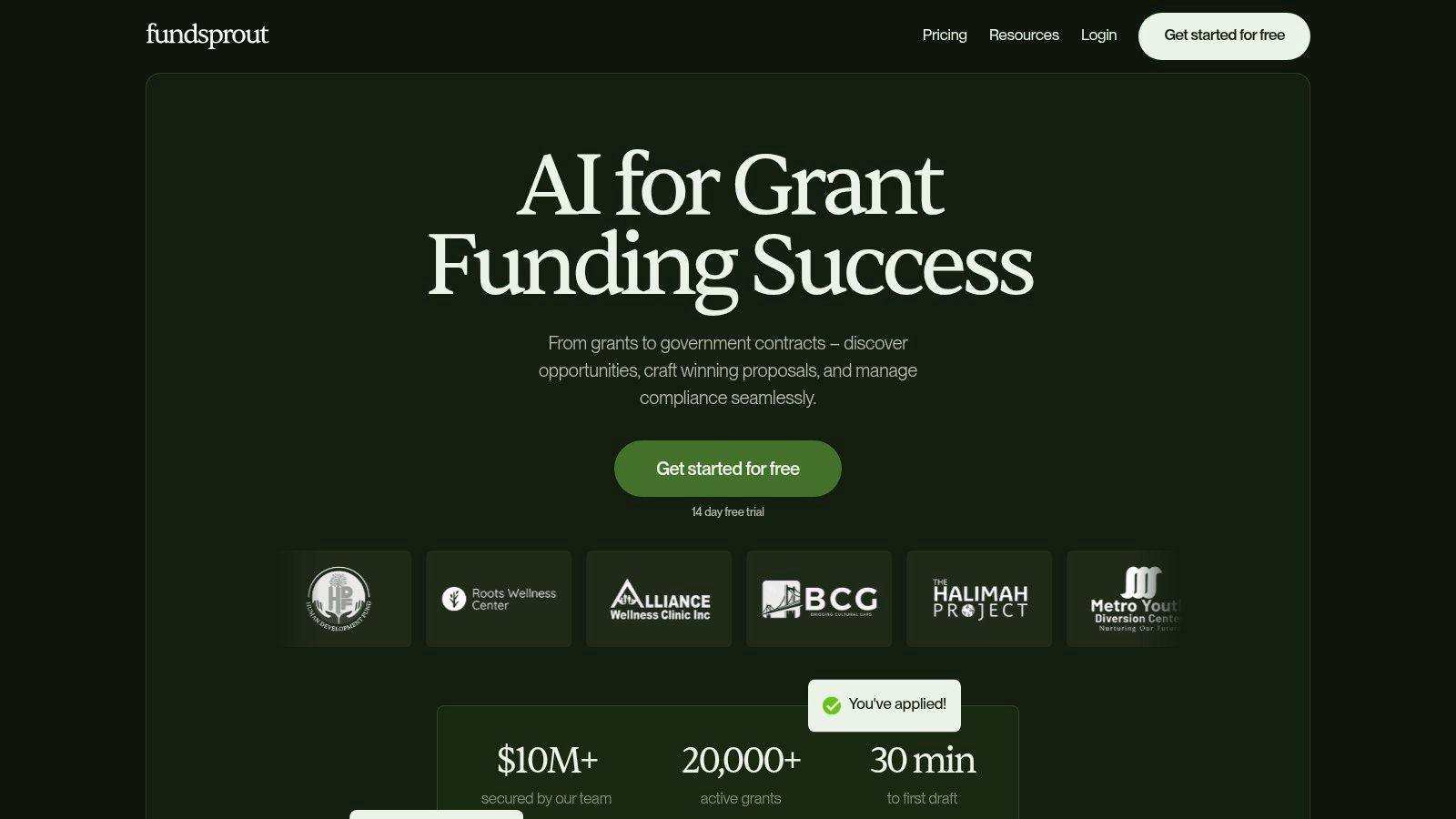
What makes Fundsprout a powerful ally is its ability to create a personalized grant pipeline by scanning over 275,000 sources daily. The AI-driven eligibility screening ensures that teachers only see opportunities with the highest probability of success, saving invaluable time and effort. Its standout AI writer can then generate compelling narratives for your grant application, tailored to your classroom's specific needs and voice, using data you provide.
Key Strengths and Use Cases
- Intelligent Grant Matching: Fundsprout’s AI analyzes your specific program needs, such as funding for assistive technology or sensory room equipment, and matches them to relevant federal, state, and foundation grants.
- Automated Proposal Writing: The AI writing assistant is a game-changer. By uploading your project descriptions and student impact data, the platform crafts first drafts of grant narratives, complete with citations. This allows you to focus on refining the proposal rather than starting from scratch.
- Integrated Project Management: Keep your application process organized with built-in tools that track deadlines, required documents, and team tasks, preventing missed opportunities.
Practical Considerations
- Pros: Access to a massive and constantly updated grant database, significant time savings through AI automation, and comprehensive project management from a single dashboard.
- Cons: The platform's effectiveness is highly dependent on the quality and completeness of the data you upload. It's primarily designed for nonprofits and educational institutions.
- Access: Fundsprout is a subscription-based service. You can explore its features and pricing at its official website.
2. Grants.gov
Grants.gov is the official, centralized portal for all federal grant opportunities, making it an indispensable, albeit complex, resource. While it doesn't offer grants directly to individual teachers, it is the primary source for large-scale funding that schools and districts can pursue for comprehensive special education programs. It consolidates opportunities from agencies like the Department of Education, providing a one-stop-shop for systemic-level funding searches.
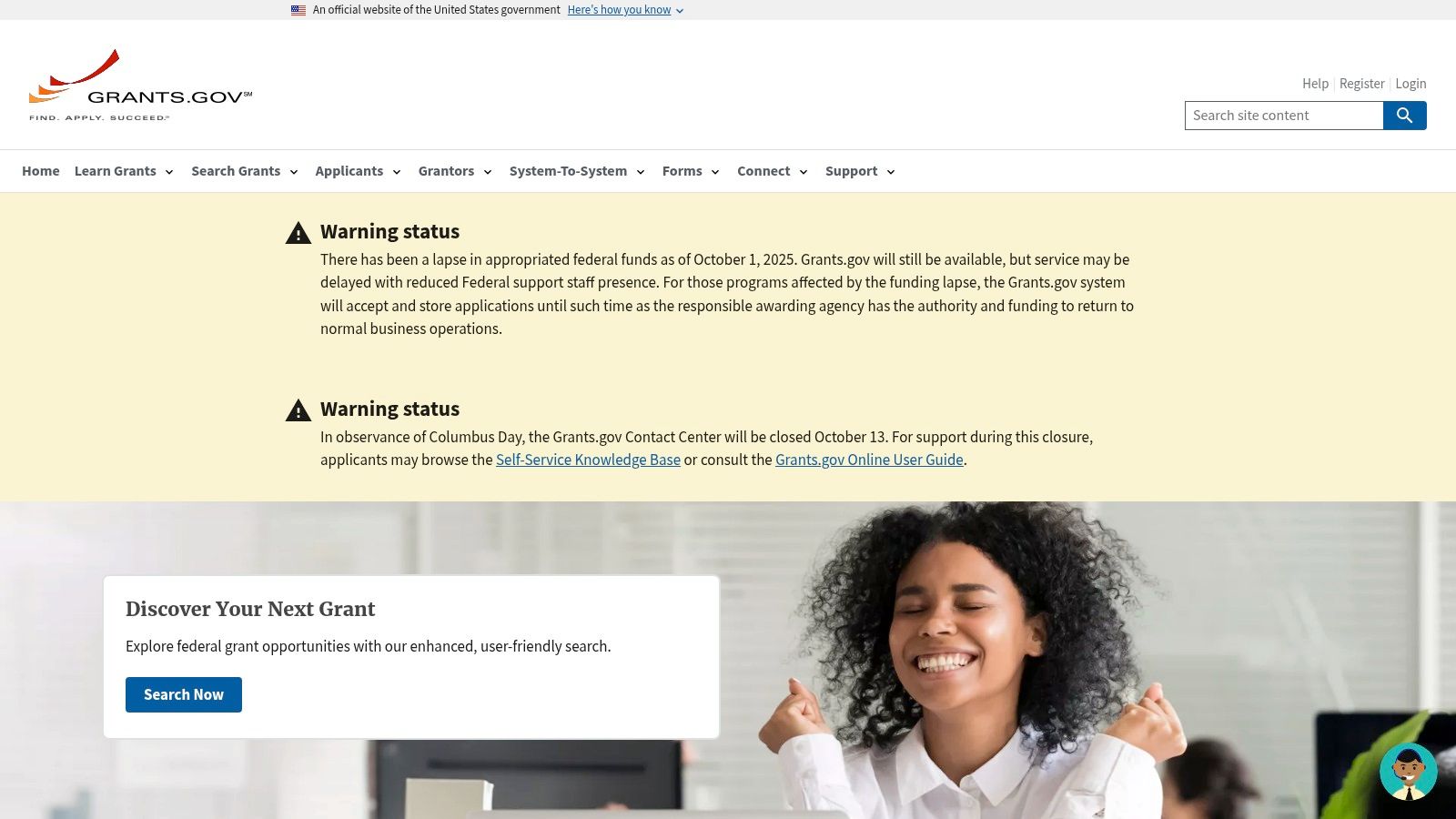
The platform is free to use but requires a rigorous registration process involving SAM.gov for organizational applicants. Its strength lies in its comprehensiveness; you won't find a more complete list of federal special education grants for teachers and their schools anywhere else. However, the interface can feel dated and overwhelming for new users.
Navigating This Federal Hub
- Best For: School districts, LEAs (Local Education Agencies), and non-profits seeking substantial federal funding for special education initiatives.
- Pro Tip: Use the advanced search filters to narrow down opportunities by keywords like "special education," "disabilities," or "assistive technology." Save your searches to receive notifications.
- Limitation: The complexity and institutional focus mean it's not a tool for quick classroom grants. Teachers should plan to collaborate with their administration to pursue these opportunities. For a more user-friendly experience exploring various funding sources, you can also learn more about using a free grant database for nonprofits.
Website: https://www.grants.gov
3. SAM.gov (Entity Registration)
While not a grant provider itself, SAM.gov is the non-negotiable first step for any school or district planning to apply for federal funding. It is the official U.S. government system for managing entity registrations, and obtaining a Unique Entity ID (UEI) here is mandatory before you can even begin an application on platforms like Grants.gov. This system consolidates several legacy systems, making it the central hub for validating an organization's eligibility for federal awards.
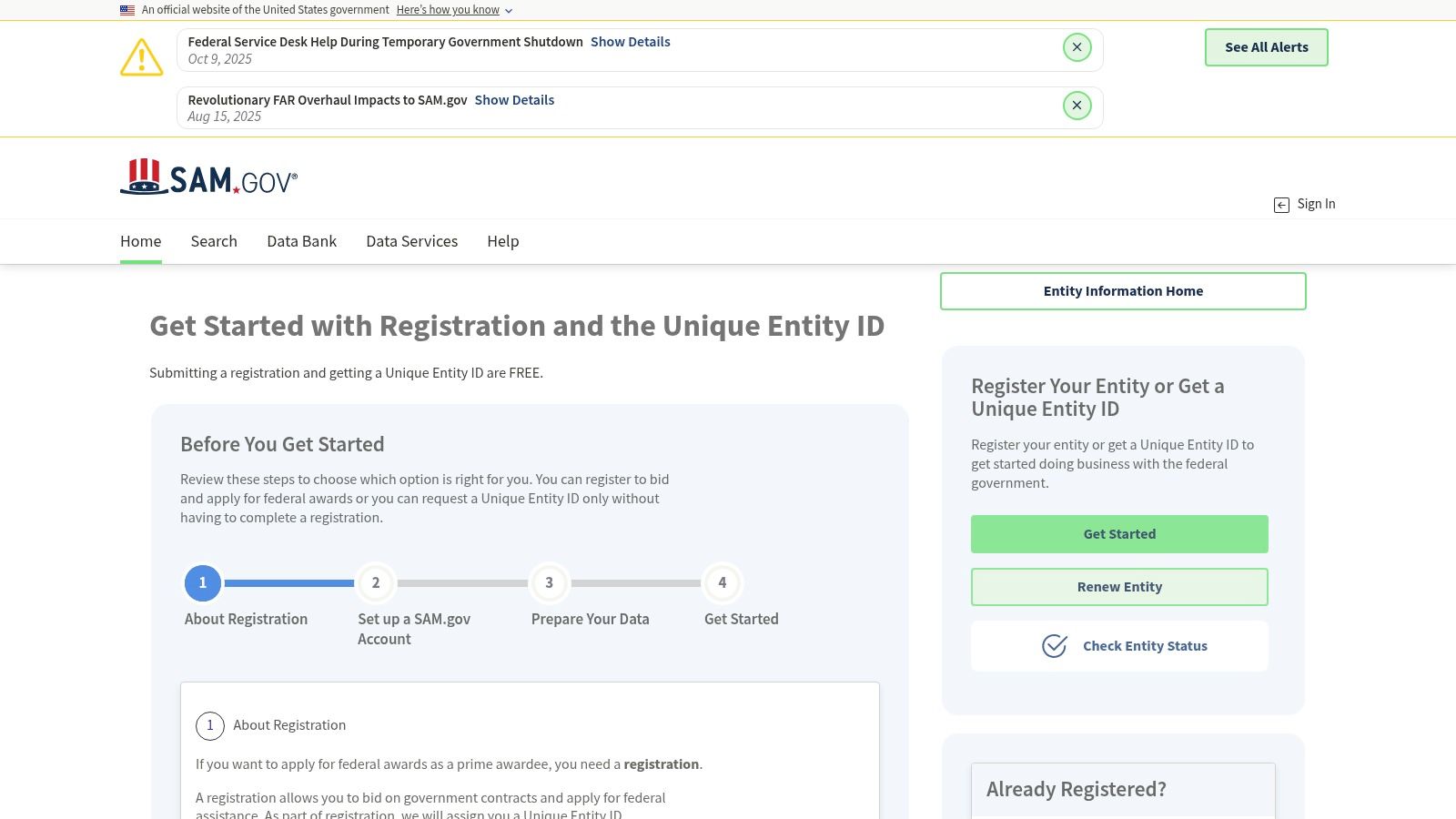
The registration is free but requires meticulous attention to detail and patience, as the validation process can take several days or even weeks. Its essential role makes it a critical part of the infrastructure for securing large-scale special education grants for teachers, even though the interface is purely administrative. Teachers should be aware that their school or district must have an active and updated registration to access federal opportunities.
Understanding This Critical Prerequisite
- Best For: All U.S.-based school districts, non-profits, and LEAs intending to apply for any federal grant, including those for special education.
- Pro Tip: Start the registration or renewal process at least a month before your intended grant deadline. Gather all necessary documents, like your organization’s Taxpayer Identification Number (TIN), beforehand to streamline the process.
- Limitation: The platform is purely for registration and entity management, not for finding grant opportunities. The validation process can sometimes face delays, which can jeopardize application timelines if not started early.
Website: https://sam.gov/content/entity-registration
4. U.S. Department of Education – OSERS/OSEP Grant Opportunities
This official government page is the direct source for grants administered by the Office of Special Education and Rehabilitative Services (OSERS) and the Office of Special Education Programs (OSEP). It is the home for IDEA-related federal formula and discretionary grants, which are foundational for state and local special education programs. It provides a focused view of high-level funding opportunities specifically designed to support research, program development, and teacher preparation in special education.
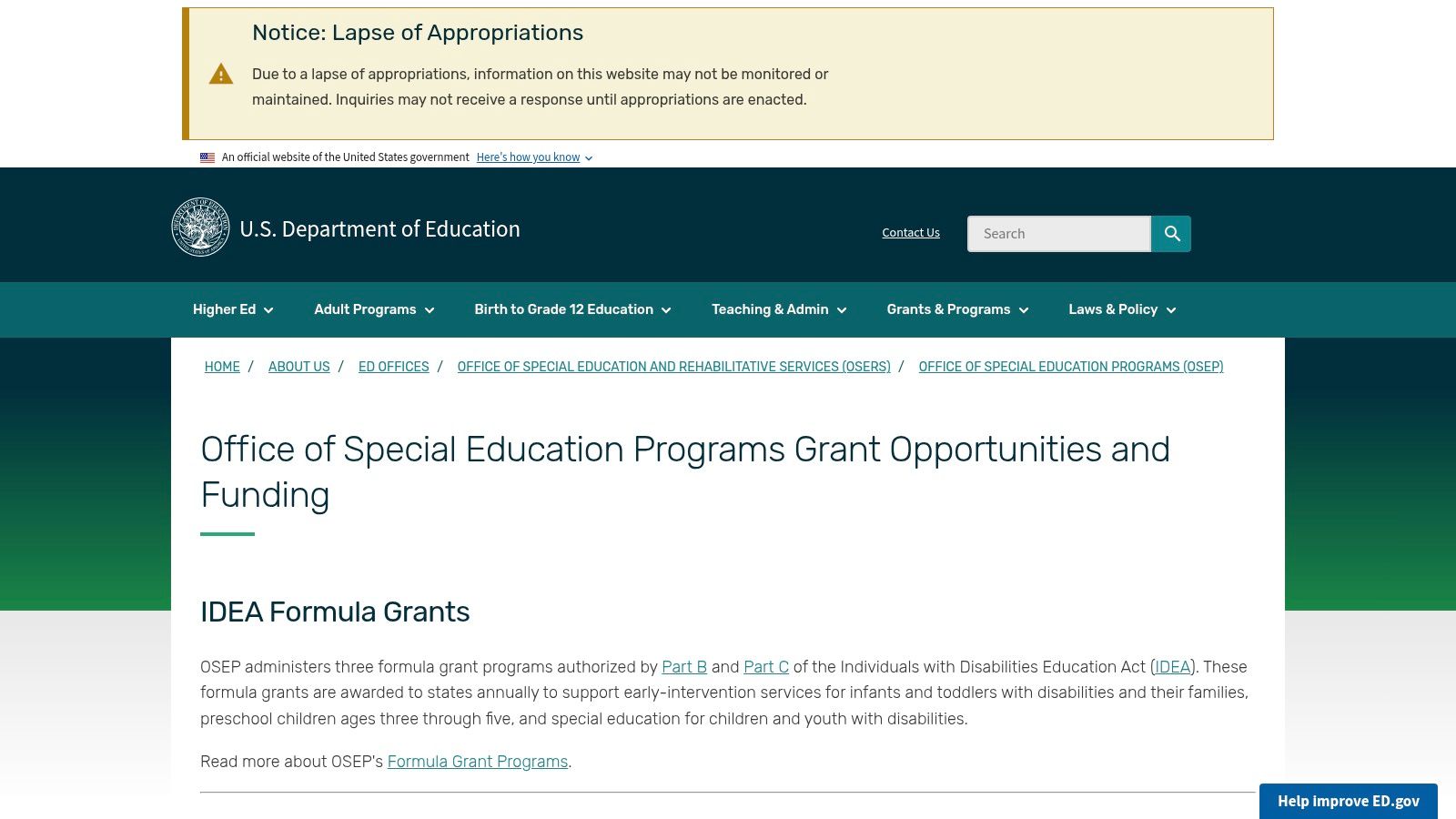
Unlike broad portals, this site concentrates solely on the grants that form the backbone of special education policy and practice in the U.S. While individual teachers are not the direct recipients, understanding these funding streams is crucial for district-level planning. The page lists current and upcoming competitions, forecasts, and essential application forms, making it an authoritative resource for administrators seeking special education grants for teachers and their programs.
Navigating This Authoritative Source
- Best For: State educational agencies (SEAs), universities, and large school districts applying for substantial IDEA-funded discretionary grants.
- Pro Tip: Pay close attention to the "Forecasts of Funding" section. This provides insight into upcoming grant competitions, giving your institution valuable time to prepare a strong proposal before the official announcement.
- Limitation: The opportunities are highly competitive, institution-focused, and operate on strict, cyclical timelines. The application process is complex and requires significant administrative capacity.
5. Institute of Education Sciences (IES) – National Center for Special Education Research (NCSER)
The Institute of Education Sciences (IES) is the research arm of the U.S. Department of Education, and its National Center for Special Education Research (NCSER) is a powerhouse for evidence-based practices. While not a source for simple classroom supply grants, it offers significant funding for research projects aimed at improving outcomes for students with disabilities, often involving direct collaboration with educators and schools.
This free-to-access federal resource is designed for large-scale, data-driven initiatives. Its uniqueness lies in its rigorous, peer-reviewed focus exclusively on special education research, providing transparent funding priorities and access to previously awarded projects for reference. The platform is geared toward systemic change rather than individual teacher needs.
Leveraging Research-Focused Funding
- Best For: Research institutions, universities, and school districts partnering on projects to develop or test special education interventions, curricula, and professional development programs.
- Pro Tip: Teachers with innovative ideas should partner with a local university or their district’s research department to build a competitive team for an NCSER grant application.
- Limitation: The application process is highly competitive, data-intensive, and not suited for individual teachers. These are special education grants for teachers in a collaborative, research-oriented context, not for immediate classroom resources.
Website: https://ies.ed.gov/ncser/research/grantsProgram.asp
6. TEACH Grant (Federal Student Aid)
The Teacher Education Assistance for College and Higher Education (TEACH) Grant is a federal program offering financial aid directly to students, including current teachers pursuing further education. It provides up to approximately $4,000 per year for individuals who agree to teach in a high-need field, such as special education, at a low-income school. This makes it a unique and powerful funding source for individuals committed to the field, rather than a grant for classroom supplies.
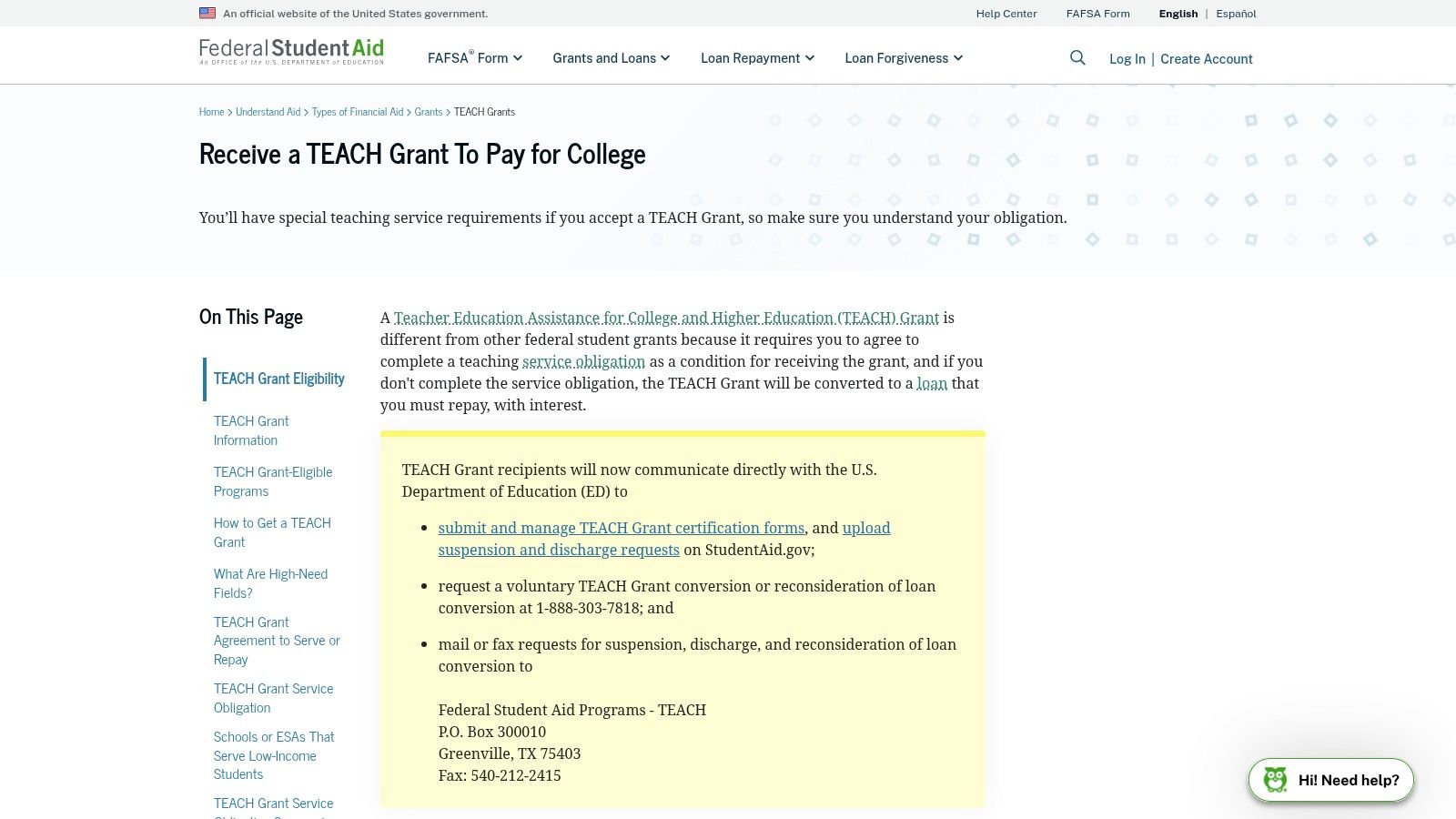
The program is administered through the Free Application for Federal Student Aid (FAFSA) process and is available at participating postsecondary institutions. Its primary strength is providing direct, substantial aid to aspiring and current educators. However, the service obligation is strict; failure to complete the required four years of teaching within eight years of graduating converts the entire grant amount into a direct unsubsidized loan that must be repaid with interest.
Navigating This Federal Program
- Best For: Aspiring special education teachers or current educators seeking advanced degrees in special education who are committed to working in high-need, low-income schools.
- Pro Tip: Maintain meticulous records of your employment to certify your service obligation annually. Stay in close contact with your grant servicer to ensure you meet all requirements and avoid accidental loan conversion.
- Limitation: This is not a project or materials grant; it is personal financial aid tied to a stringent service agreement. It is one of the most significant special education grants for teachers at the individual level, but the long-term commitment and potential for loan conversion require careful consideration.
Website: https://studentaid.gov/understand-aid/types/grants/teach
7. NEA Foundation – Student Success Grants
The NEA Foundation provides direct funding to educators through its Student Success Grants, offering a valuable pathway for classroom-level projects. These competitive grants provide up to $5,000 for initiatives designed to improve student outcomes, making them an excellent resource for those seeking special education grants for teachers to implement inclusive practices, purchase adaptive materials, or launch personalized learning programs. The application is designed by educators for educators, focusing on practical impact over bureaucratic complexity.
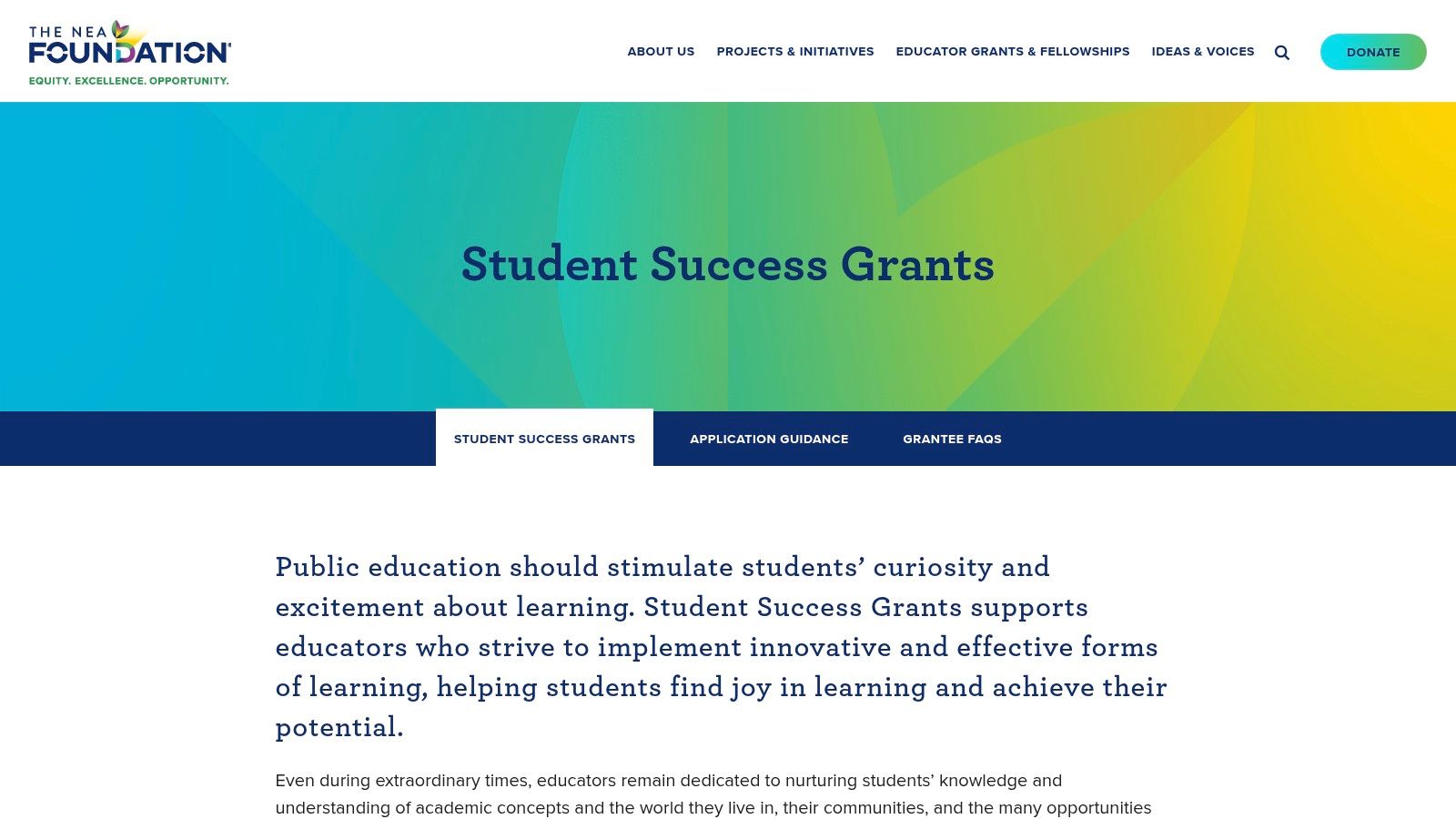
This grant is accessible to a wide range of school staff, including teachers, educational support professionals, and specialized instructional support personnel, provided they are current NEA members. The funding supports a project over a 12-month period, giving educators ample time to implement their ideas and measure the results. Its focus on classroom-centric proposals makes it stand out from larger, district-level grants.
Funding Your Classroom Vision
- Best For: NEA-member teachers and support staff looking for funding for a specific, year-long classroom project or school-wide initiative focused on inclusion or student support.
- Pro Tip: Clearly articulate how your project will directly support the academic success of students with disabilities. Use specific examples of proposed activities and desired outcomes in your application.
- Limitation: Access is restricted to current members of the National Education Association (NEA), and you cannot hold more than one NEA Foundation grant at a time.
Website: https://www.neafoundation.org/educator-grants-and-fellowships/student-success-grants/
8. American Federation of Teachers (AFT) – Innovation Fund Mini-Grants
The American Federation of Teachers (AFT) Innovation Fund provides substantial grants to its local affiliates for projects that support educators and students. While not exclusively for special education, many funded initiatives focus on inclusion, specialized literacy programs, and community support systems that directly benefit students with disabilities. This fund empowers union locals to pilot and scale creative solutions to pressing educational challenges.
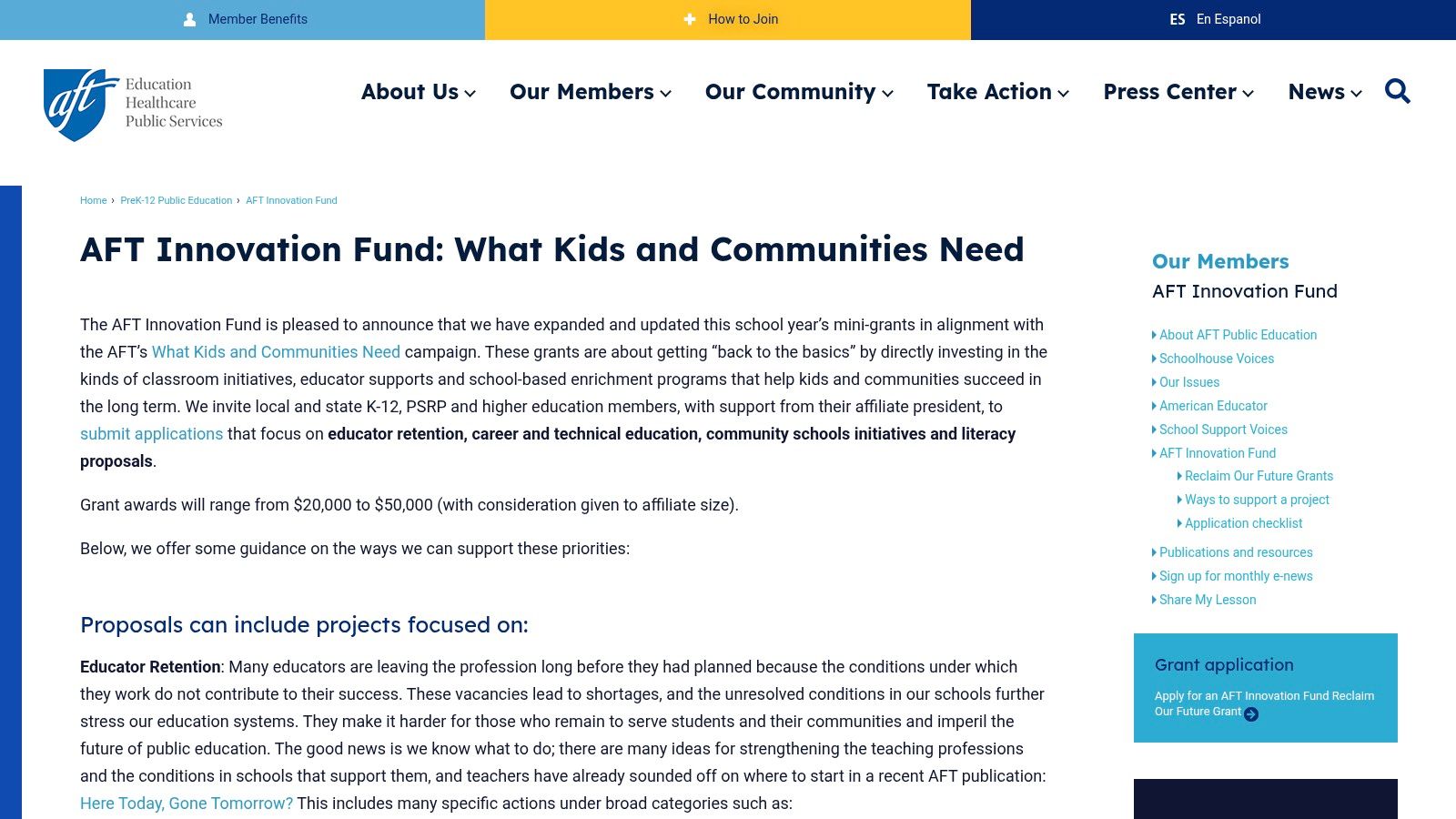
With awards ranging from $20,000 to $50,000, the fund offers a pathway to significant resources for systemic change. The program is aligned with AFT's 'What Kids and Communities Need' campaign, prioritizing holistic, community-based projects over isolated classroom activities. This focus makes it a unique source for ambitious special education grants for teachers who can mobilize their local union leadership.
Leveraging Union-Led Initiatives
- Best For: Teachers who are active AFT members and can partner with their local or state affiliate to champion a large-scale project.
- Pro Tip: Start by discussing your project idea with your local union representatives. A strong proposal will demonstrate broad support and a clear plan for implementation across multiple schools or with community partners.
- Limitation: This is not a direct-to-teacher grant. The application must be submitted and managed by an AFT affiliate, making it inaccessible for individual teachers acting alone. For those new to this level of funding, it's helpful to review a guide on grant writing for beginners.
Website: https://www.aft.org/about/innovation-fund/aft-innovation-fund-what-kids-and-communities-need
9. DonorsChoose (Special Education Projects)
DonorsChoose is a popular U.S. crowdfunding platform that empowers individual teachers to request funding for classroom materials and experiences directly from the public. While not a traditional grant, it serves as a powerful, teacher-driven funding mechanism, especially for acquiring specific supplies, technology, and sensory tools needed for special education students. The platform's high transparency allows donors to see exactly where their money is going, building trust and engagement.
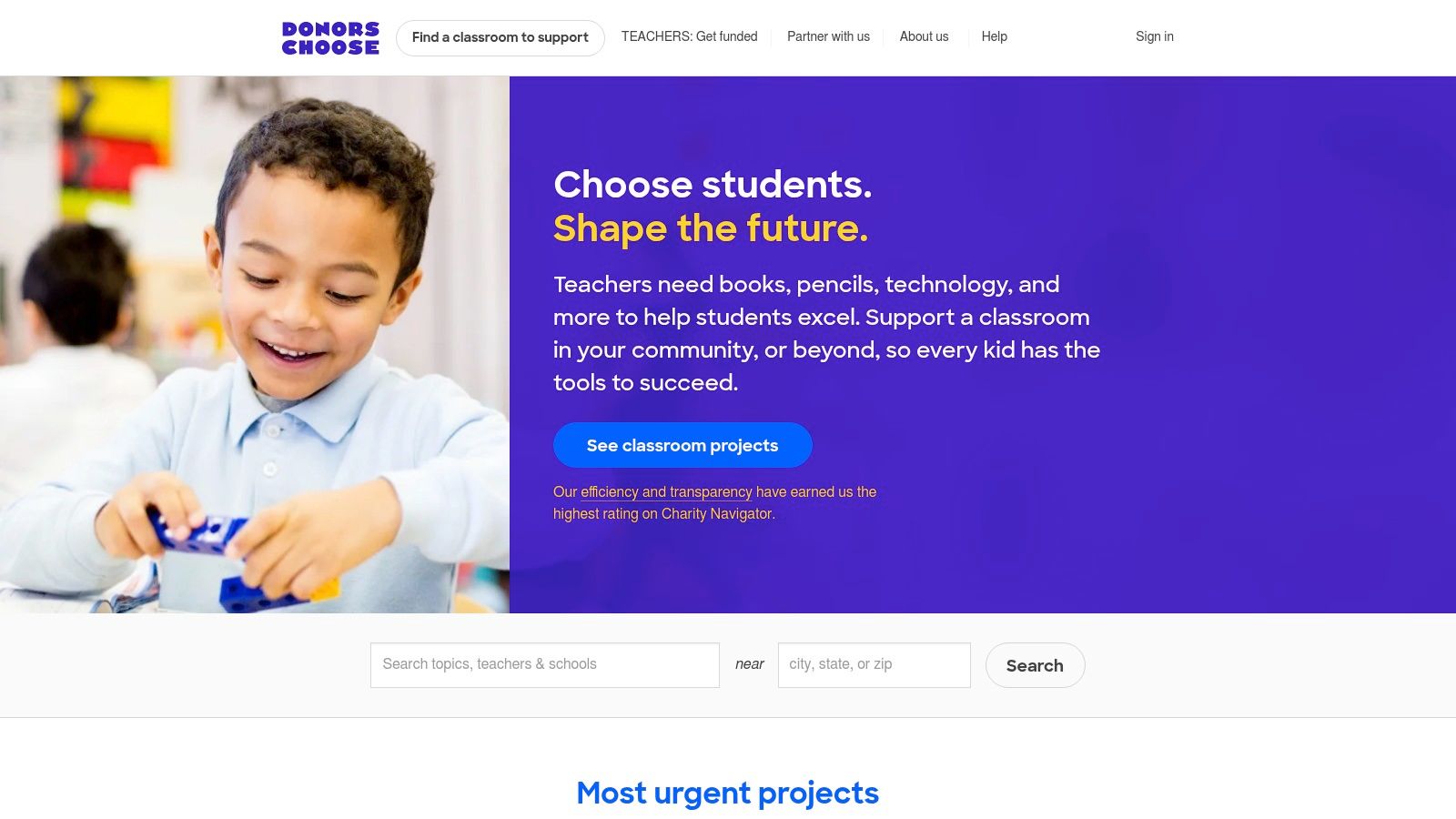
The site is free for public school teachers to use. Once a project is fully funded, DonorsChoose purchases the requested items and ships them directly to the school, ensuring accountability. Its unique strength is providing fast, targeted special education grants for teachers who need specific classroom resources without navigating complex district-level procurement processes. The platform often features corporate and foundation matching offers, which can double donations and help projects get funded faster.
Navigating This Crowdfunding Leader
- Best For: Individual special education teachers, speech therapists, and OTs needing specific classroom supplies, adaptive equipment, or sensory materials.
- Pro Tip: Create a compelling project page with photos and a clear story explaining how the requested materials will directly benefit your students. Share your project widely on social media to increase visibility.
- Limitation: Funding is entirely dependent on donor interest and your promotional efforts. Not all projects get funded, and it's less suitable for large-scale program funding.
Website: https://www.donorschoose.org
10. AdoptAClassroom.org (Inclusive Classroom Fund + Spotlight Funds)
AdoptAClassroom.org is a nonprofit crowdfunding platform that directly supports teachers with micro-grants for classroom materials. It stands out by offering dedicated funding streams, like the Inclusive Classroom Fund and various Spotlight Funds, which specifically address the needs of diverse learners. These grants provide PreK-12 educators with flexible funding to purchase supplies from an extensive marketplace of approved vendors, empowering them to create more accessible and supportive learning environments.
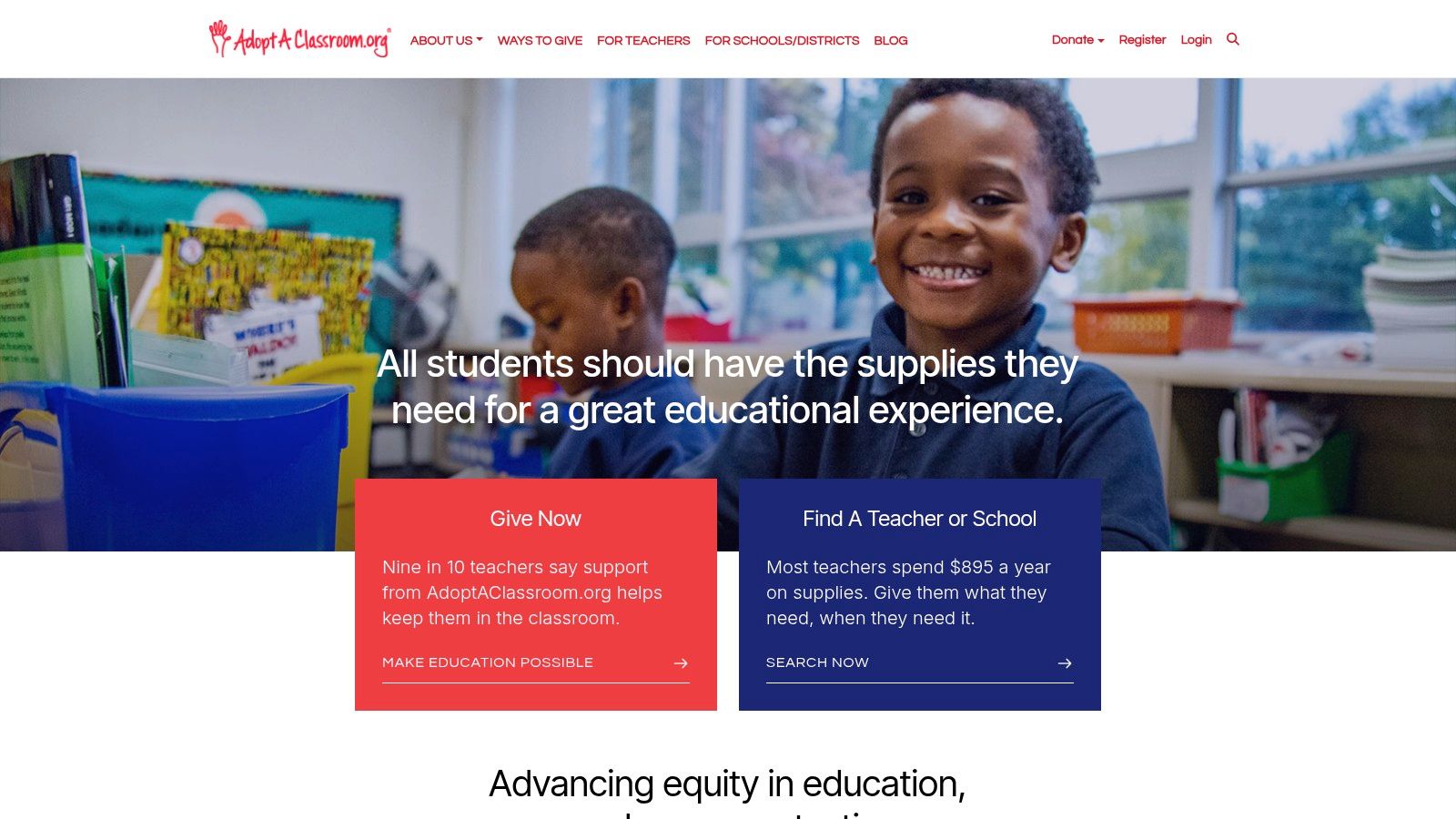
The platform is designed for individual teachers, making it one of the most direct ways to secure special education grants for teachers without complex district-level applications. The application process is streamlined through a personal dashboard, though it requires maintaining an active classroom page. With multiple funding cycles and themes focused on everything from STEM to social-emotional learning, it offers recurring opportunities for targeted support.
Navigating This Direct-to-Teacher Platform
- Best For: Individual PreK-12 special education teachers needing quick, flexible funds ($500-$750) for specific classroom resources like sensory tools, adaptive equipment, or inclusive literature.
- Pro Tip: Regularly update your classroom page and apply for multiple Spotlight Funds when their themes align with your students' needs. Clearly articulate how the funds will promote inclusivity and support IEP goals.
- Limitation: The grants are competitive, and funds are restricted to purchases within the platform's vendor marketplace, which may not include every specialized item a teacher needs.
Website: https://www.adoptaclassroom.org
11. Fund for Teachers (FFT)
Fund for Teachers (FFT) offers a unique fellowship model, empowering educators to design their own professional learning odysseys. Instead of funding classroom supplies directly, FFT provides grants for self-designed summer experiences that teachers can tailor to specific special education challenges, such as learning new inclusive teaching methodologies or mastering assistive technology abroad. This approach positions educators as experts in their own professional growth.
The platform is free to use for applicants, but the fellowship is highly competitive and requires a well-researched, compelling proposal. Its strength is the unparalleled flexibility it offers, allowing educators to pursue passion projects that have a direct, tangible impact on their students. It's a fantastic resource for special education grants for teachers who have a clear vision for how a specific professional development experience will transform their classroom practice.
Designing Your Dream Fellowship
- Best For: Experienced PK–12 teachers (3+ years) with a specific professional development goal that requires immersive, hands-on learning.
- Pro Tip: Frame your proposal around a problem or need within your special education classroom. Clearly articulate how your proposed fellowship will directly lead to a solution and improved student outcomes.
- Limitation: The annual application cycle is highly competitive and demands a significant time investment to create a strong proposal. This is not for last-minute funding needs.
Website: https://fundforteachers.org/grants/
12. Classroom Grants (Association of American Educators and Toshiba America Foundation)
This entry combines two powerful, teacher-focused grant providers: the Association of American Educators (AAE) and the Toshiba America Foundation. AAE offers straightforward micro-grants for general classroom needs, while Toshiba provides larger, project-based funding specifically for STEM. Both are excellent avenues for special educators seeking to directly fund specific classroom initiatives without extensive district-level bureaucracy.
These grants stand out because they are teacher-driven and application processes are relatively simple compared to federal opportunities. AAE's grant is perfect for acquiring adaptive materials or sensory tools, while Toshiba's supports ambitious, hands-on STEM projects that can be tailored for students with diverse learning needs. They offer some of the most accessible special education grants for teachers who have a clear and immediate classroom goal.
Tapping Into Teacher-Centric Funding
- Best For: Individual special education teachers seeking funds for specific classroom materials (AAE) or innovative, hands-on STEM projects (Toshiba).
- Pro Tip: For Toshiba grants, clearly articulate how your STEM project incorporates principles of Universal Design for Learning (UDL) to make it accessible and engaging for all students, including those with disabilities.
- Limitation: AAE grants are small (up to $500) and highly competitive, while Toshiba grants are strictly limited to STEM and do not cover general technology like laptops or tablets. For broader organizational improvements, you might explore nonprofit capacity building grants.
Websites: https://www.aaeteachers.org/selected-projects and https://www.toshiba.com/taf/612.jsp
Special Education Grants: 12 Resource Comparison
Start Your Funding Journey and Empower Your Students
Navigating the world of special education grants for teachers can feel like a monumental task, but as we've explored, a wealth of opportunities exists to transform your classroom and enrich your students' learning experiences. The key to unlocking these resources lies not in applying for every grant available, but in strategically identifying the ones that align perfectly with your unique vision and your students' specific needs.
This guide has walked you through a diverse landscape of funding options. From the comprehensive federal databases like Grants.gov and the U.S. Department of Education to grassroots crowdfunding platforms such as DonorsChoose and AdoptAClassroom.org, each avenue offers distinct advantages. Federal grants provide substantial funding for large-scale, research-backed initiatives, while foundation grants from organizations like the NEA and AFT support innovative, teacher-led classroom projects.
Key Takeaways for Your Grant-Seeking Strategy
To maximize your success, remember these core principles:
- Alignment is Everything: Your project's goals must directly match the funder's mission. A brilliant idea submitted to the wrong foundation is an automatic rejection. Re-read the funder's priorities before you even begin writing.
- Tell a Compelling Story: Grant applications are more than just a request for money; they are a narrative. Use specific, data-driven examples to illustrate the challenges your students face and paint a clear picture of how the funding will create a tangible, positive impact.
- Preparation Prevents Poor Performance: Meticulous planning is non-negotiable. Start by creating a detailed project budget, outlining clear and measurable objectives, and gathering all necessary documentation (like your SAM.gov registration for federal grants) well before the deadline. Missing a single required document can disqualify your entire application.
Your Actionable Next Steps
Feeling overwhelmed? Start small. A DonorsChoose project for sensory equipment or an AdoptAClassroom.org campaign for adaptive technology can provide a quick win and build your confidence. These platforms are excellent training grounds for learning how to articulate your needs and demonstrate impact.
For those ready to tackle larger foundation or federal grants, the process demands more rigor. Use the resources we've discussed as your starting point. Begin by exploring the NEA Foundation or AFT grants for projects under $5,000. As you gain experience, you can then set your sights on more substantial funding from sources like the Institute of Education Sciences.
Ultimately, securing a grant is a powerful affirmation of your dedication and innovative spirit. Each successful application brings you one step closer to providing the specialized tools, adaptive technologies, and enriching experiences your students deserve. The journey requires persistence and precision, but the potential to empower your students and create a more inclusive, effective learning environment makes every bit of effort worthwhile.
Ready to streamline your search and amplify your success? Fundsprout uses AI to match your specific classroom needs with the perfect grant opportunities, helping you find funding faster and write more compelling proposals. Stop spending hours searching and start funding your vision at Fundsprout today.
Try 14 days free
Get started with Fundsprout so you can focus on what really matters.
